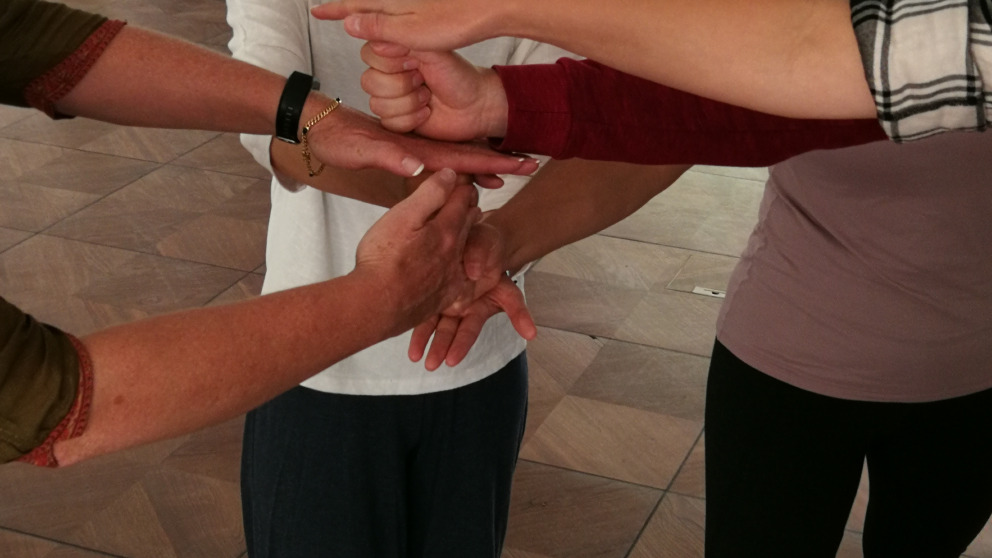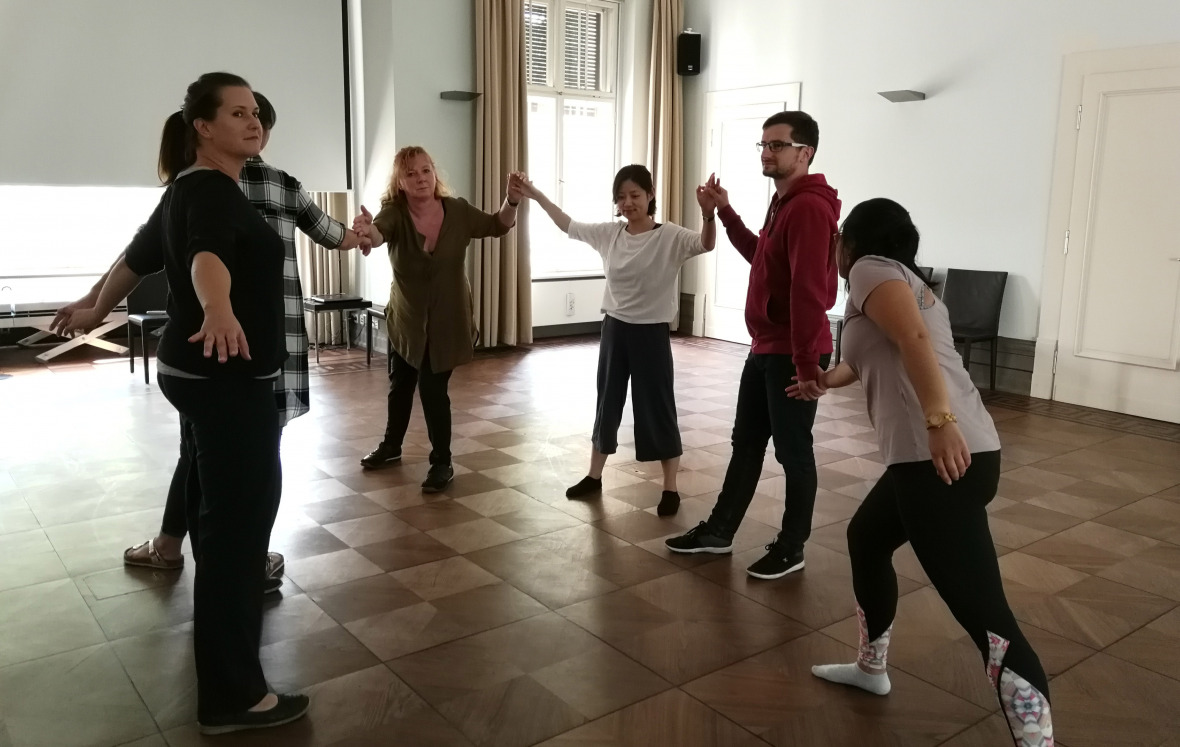Dance and Movement as a Tool for Sustainability
09.11.2018

What can the arts contribute to sustainability? How can they shape new mindsets and approaches to the challenges we face? A series of workshops at the IASS seeks to build bridges between various forms of artistic expression and sustainability. The latest workshop focused on dance and movement. It was facilitated by Martina Piff, a dance and expression therapist and chair of the Professional Association of Dance Therapists in Germany. She encouraged participants to experience non-verbal communication within the group and observe how movement plays a role in self-exploration, communication, and collaboration.
Our bodily awareness constantly moves between the self, others and our environment. After the initial warm-up, Piff challenged each participant to express their emotional and physical state through body language. The other participants then mirrored those gestures in a kind of empathetic response. In that way, non-verbal connections were made.
When participants were later told to slip into the role of leader or follower by moving accordingly, it immediately became clear who was playing what role. This was a good exercise in non-verbal communication for researchers who are accustomed to expressing themselves through language. The workshop encouraged them to turn an intention into an action through body language. The ‘leaders’ in this game were invited to show rather than tell their ‘followers’ what they wanted in a friendly and inclusive way. And the followers’ responses to physical gestures can be seen as a form of cooperation.
Non-verbal communication with stakeholders
Being sensitive to people’s preferences and personal space is important when we are building relationships with stakeholders. By communicating non-verbally with the workshop participants, we learned how body language
- shapes our physical appearance and gestures;
- can amplify what we are saying about environmental or human rights issues;
- helps us to send messages and elicit responses from others in a more efficient way.

A creative and organic solution to conflicts
Bodily actions trigger reactions – both friendly and defensive – in a very direct and spontaneous way. This was confirmed at another stage of the workshop when participants were divided into pairs and asked to give and carry out ‘instructions’ in a non-verbal way. When I gestured to my partner to come towards me she went in the opposite direction at first, and this revealed her particular communication preferences as a kind of ‘body memory’.
Workshop participants also experimented with ‘light physical touch’ and ‘personal space exploration’. Light physical touch and the feedback from that touch revealed the trust related to intimacy or conflict. It became clear that perceiving one’s own body in movement is a way of experiencing the interconnectedness of the self, others and the environment. It can also be a way of rebuilding trust on a non-verbal level: a hand on the shoulder of a conversation partner or the act of shaking hands communicates the intention to create a more sustainable connection with that person.
As a channel of communication, movement can help to build trust among different stakeholders. At the workshop, non-verbal communications between participants with different cultural and disciplinary backgrounds were not always free of tension or room for misinterpretation. For example, participants with an Asian background were generally more hesitant and guarded. But even when there was hesitation or uncertainty at the beginning of an interaction, diversity ultimately turned out to be a useful resource for dealing with conflict. The organic development of interaction through body language helped to make the communication process explicit, visible and sincere, promoted concentration and empathy, and raised participants’ level of commitment.
“It’s not a dance performance”
According to the American Dance Therapy Association, “Dance/movement therapy is the psychotherapeutic use of movement to promote the emotional, social, cognitive and physical integration of the individual.” It is the method of using body language and non-verbal communication, an innate primitive quality inherent in every living thing, to validate and support an individual’s existence and to facilitate change and growth.
You do not have to be a dancer or have any dancing skills to participate or benefit from a dance and movement workshop. The only requirements are a heartbeat, a breath, and a willingness to explore the self.
Comments/take-home messages from the participants:
From Inaiê:
“For now, I would reinforce the relevance of yesterday’s workshop for communication purposes and link it to an essential aspect of transdisciplinary research (TDR). We don’t just communicate with words. In TDR, both cognitive and non-cognitive factors are important, as far as I understand.
We often take it for granted that integration at different levels (disciplines, knowledge systems, working groups, theory-practice, etc.) will happen of its own accord. My main take-home message from the workshop is the potential of dance and movement to help build trust and solid relationships, not only among scientists but also between scientists and actors from outside of academia, and this is essential to societal transformation. I really enjoyed the practice and discussions!”
From Jyoti:
“Though I could not attend the whole session, even the first half was beneficial to me as it helped me to relax on a physical, mental, and emotional level. Beyond my day-to-day work and busy life, that was the moment that I could re-energise myself with the flow of soothing music and dance moves. So overall, my take-home message from the session I attended is that dance as a body movement can foster communication, satisfaction, connection, empowerment, healing and relaxation."
From Man:
"I am totally inspired by the saying that it is not about our different professional identities and all about human beings. Simply being aware of the body and behavioral change can directly impact our actions, which means that transformation can happen without language.
Body language is very direct and frank, and it becomes a visible form of expression if we are aware of it. It reminds me of how we arrange the participation of stakeholders efficiently with different individual personal spaces and automatic resistance when they are unexpectedly invaded. The practice of dance and movement makes all our behavioral patterns visible to others."
During the workshop, creative forms of communication/discourse evolved organically from the interactions through movement, and I hope to bring this experience to bear in the practice of communicating with stakeholders.
Workshop moderation:
Martina Piff is a dance and expression therapist (BTD, ECP), chair of the Professional Association of Dance Therapists in Germany and Pedagogical Director of the Langen Institute School of Dance and Expression Therapy. She is also active as a teacher of dance therapy in various locations in China and India.